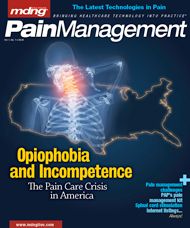Publication
Article
MDNG Pain Management
Chronic Pain
//The Educated Patient
American Chronic Pain Association: Communication Tools
Patients can download useful pain-management tools at this site, which they can bring with them to the hospital, a doctor’s appointment, or use at home to keep track of their pain or treatment program. For example, the follow-up visit card allows a patient to keep track of tests that need to be taken before the next visit, treatments that need to be adhered to, and activities that should be done or avoided. Similarly, a quality-of-life scale form can be downloaded through the site with which patients can rate their quality of life based on a number of factors. The site also contains a list of diseases associated with chronic pain, ranging from temporomandibular joint and muscle disorders to fibromyalgia; a number of videos, including a “Consumer Guide to Pain Medication and Treatment;” and a collection of surveys on chronic pain.
Link Code: 3421
//Medical Websites
Clinical Care Guidelines
Those looking to refresh their memory on chronic pain guidelines or read up on the latest updates should visit this site from the University of Michigan Health System. In the “Managing Patients with Chronic Non-Terminal Pain” section, visitors can click on the pain guideline, which reviews diagnosis, treatment, guidelines for initial patient visits, items to look for when examining patients, and the common medications used to treat the condition. The section also offers tools for physicians, including downloadable documents like “discontinuing opioids,” which discusses the methods and reasons behind altering dosages.
Link Code: 3411
Chronic Pain Communication Skills
This blog features a number of videos presented by Dr. Peter Mackenzie, Consultant in Anesthesia and Pain Management, and Dr. David Craig, Consultant Clinical Psychologist at the New Victoria Hospital, Glasgow. Four of these videos featured in the April 2010 answer questions on how physicians can successfully communicate with their patients. Among these questions are: “What is the impact of chronic pain on the individual and society?” and “What are the effects of chronic pain on absence from work?”
Link Code: 3412
//Online CME
Pain Report #12 Optimizing Chronic Pain Management in Elderly Persons: Integrating Pharmacokinetics & Pharmacodynamics
Credits: 1.00
Fee: Free
Expires: March 31, 2012
Multimedia: None
This activity discusses the “prevalence and consequence of undertreatment of chronic pain,” and the “principles related to the evaluation of pain in the geriatric population, including the barriers to proper pain assessment in the elderly.” Participants should be able to “outline the pharmacokinetic and pharmacodynamuc principles related to rational polypharmacy with respect to pain management in the elderly” upon completion.
Link Code: 3431
//eAbstracts
Drug Treatment of Chronic-intermittent Abdominal Cramping and Pain: A Multi-national Survey on Usage and Attitudes
Journal: Alimentary Pharmacology & Therapeutics
Authors: Mueller-Lissner S, Quigley E, Helfrich I, Schaefer E
Purpose: The authors sought to examine data on the treatment of abdominal cramping and pain across countries to form comparisons.
Results:
A multi-national survey was conducted in the USA, Mexico, Brazil, Argentina, Germany, Belgium, Italy, and the UK. There were 1,717 participants, who were “interviewed on various aspects of drug treatment of their complaints.” Results demonstrated that those “from the Americas used more medication (about 90%) than those from Europe (about 70%).” Mostly, over-the-counter remedies were used rather than prescription drugs (except in Mexico). Further results showed, “The majority of people afflicted by abdominal cramping and pain use medication and take them on demand. Consequently, rapid onset of action is mentioned as most important. Antispasmodics are the class most frequently used with considerable variation from country to country.”
Link Code: 3451
//Clinical TrialsA Telephone Feedback System for Prevention of Chronic Pain Relapse
Study Type: Interventional
Age/Gender Requirement: 18 years (male/female)
Sponsor: National Institute of Arthritis and Musculoskeletal and Skin Diseases
Purpose: The study is designed to determine if a “telephone-based self-monitoring and skills review program with personalized therapist feedback following group CST for chronic pain can reduce and prevent relapse of the pain, physical disability, and psychological distress experienced by patients with chronic pain of the muscles and bone.”
Link Code: 3461






